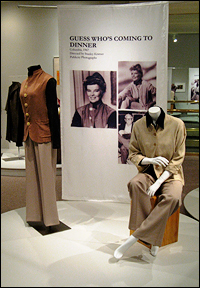
***
In 1985, at its annual awards ceremony saluting the hallmarks of American fashion, the Council of Fashion Designers of America presented Katharine Hepburn with a Lifetime Achievement Award. Katharine Hepburn, you ask? She of the slacks and "so-what" school of fashion? You wouldn't be off base to wonder. And you wouldn't be alone. After all, when she accepted the award, she, too, sounded a humorous, puzzled note. "We're all in a serious spot," she said, "when the original bag lady wins a prize for the way she dresses."
But anoint her they did, with two of the most noted purveyors of American design, Perry Ellis and Calvin Klein, leading the applause and pronouncing her the epitome of style. Hepburn's acceptance of an award from the world of fashion (let alone her up-til-then unprecedented acceptance of any award) was a hint that she knew far more about that world than she let on. In her steadfast devotion to casual, comfortable dress — from her earlier well-tailored slacks and female versions of men's suits to the later-in-life scruffier, more lived-in "couture" — Hepburn crafted a style that was both uniquely personal and quintessentially American. She was one classy bag lady.
In life, she liked to look as if she didn't give a rap. "I think you should pretend you don't care," she told Klein in an interview for the CFDA's program. "But it's the most outrageous pretense. I said to Garbo once, 'I bet it takes us longer to look as if we hadn't made any effort than it does someone else to come in beautifully dressed.' . . . I enjoy line. I am very aware . . . although I dress in rags."
| |
 |
|
| Paul Clemens' oil painting of Hepburn wearing one of Walter Plunkett's costumes for "Sea of Grass" | ||
| photo courtesy of Kent State University Museum |
| |
 |
|
| Motley's costumes for "Long Day's Journey Into Night." | ||
| photo courtesy of Kent State University Museum |
There are plans for the exhibition to tour the United States and abroad when it winds down at Kent State, notes James Harris, whose company H/L Communications handles the publicity and special programming concerning the show, which to date has included a gala opening in September attended by Turner Classic Movies host Robert Osborne (who declared the exhibit superior to the recent one for Grace Kelly at the Victoria and Albert Museum in London) and screenings of Hepburn movies like "Adam's Rib," "Summertime" and "Holiday." But for fellow fans who can't hold out til then, I recommend they either take a trip to Kent, OH — as I did in early December 2010 — or join me now for a walking tour of "Katharine Hepburn: Dressed for Stage and Screen."
| |
 |
|
| Hepburn (flanked by David Wayne and Paula Ray) gets fastened by Spencer Tracy in "Adam's Rib." | ||
| photo courtesy Kent State University Museum |
—Lawyer Amanda Bonner (Hepburn) to lawyer husband Adam (Spencer Tracy) as they dressed for dinner in "Adam's Rib" (1949)
Though she was famously famous for wearing pants (everywhere) off screen, Hepburn wore any number of beautiful dresses on screen, and some of the ones with which she is most identified grace the exhibit. The first dress on display is one that fans will forever associate with the line, "The calla lilies are in bloom again": Muriel King's lovely gray marquisette and silk chiffon evening gown and underdress that Hepburn wore as aspiring actress Terry Randall in the final scenes of RKO's "Stage Door" (1937). Accenting the dress is a wide, buttoned, blue silk belt, which is a reproduction, made after images of Hepburn on the movie's poster. Aside from the bodice's lovely cascade of ruffles, what strikes one immediately is how slender Hepburn was. Looking at this dress and others in the exhibition, I found myself wondering how it was possible that internal organs resided in such a small frame. "Whenever you dress a mannequin," Druesedow relates in the video noted above, "you realize that you have to make the mannequin fit the dress, rather than the dress fit the mannequin, and when we first began to look at the Hepburn things we realized that she was extraordinarily tiny when she was a young woman and not very much larger when she was an older woman. It turned out that we had to carve a mannequin to match Katharine Hepburn's measurements as a young woman, which was a waist of about 20-and-a-half inches and a rib cage of about 23 inches."
| |
 |
|
| Muriel King's chiffon creation for Katharine Hepburn in "Stage Door." | ||
| courtesy of Kent State University Museum |
Turn the bend and one is greeted by a tableau of three costumes designed by Motley for "Long Day's Journey Into Night" (1962). Hepburn garnered her ninth Oscar nomination for what many consider to be her greatest performance as drug-ravaged Mary Tyrone in the Sidney Lumet-directed version of the Eugene O'Neill drama. On display are the two dresses she wore in the film — one, a cream floral patterned cotton voile trimmed with decorative ball fringe; and the other, a lavender linen creation bedecked with crocheted lace — as well as the white cotton robe with red and black pattern that she wore in the final scene where at her nadir, Mary wanders around the Tyrone house, her wedding dress in tow. One of the most enjoyable aspects of this exhibit is that it affords fans an opportunity to see what these costumes looked like in color. Prior to 1967's "Guess Who's Coming to Dinner," Hepburn had only made a handful of movies in color (1951's "The African Queen" and 1955's "Summertime" are standout examples), and the colors of the "Journey" costumes, in particular, were a complete surprise.
Another great American playwright in whose work Hepburn appeared was Edward Albee. In 1973, as part of the American Film Theatre series, she starred with Paul Scofield, Kate Reid, Lee Remick, Joseph Cotten and Betsy Blair in A Delicate Balance, Albee's brutal examination of a discontented and dysfunctional upper-class suburban family, directed by Tony Richardson. Hepburn's suburban matron, for whom maintaining order was paramount, was outfitted superbly by Maggie Furse and three of those character-driven costumes are on display: a leopard print synthetic caftan and jumpsuit, a black patterned velvet robe over black jersey jumpsuit, and a red wool bathrobe and tie with off-white silk satin gown. Another Walter Plunkett creation is represented not by an actual costume, but by a painting. Collaborating with Hepburn, Plunkett created a meticulously researched and devastating collection for the star's role in "The Sea of Grass" (1947), the fourth of nine films she made with Spencer Tracy, and he commissioned artist Paul Clemens to paint her wearing one of the costumes. The original oil on canvas work, on loan to the museum from collector Christopher Sullivan, depicts Hepburn in a velvety green creation accented with a stylish bustle and matching parasol.
| |
 |
|
| Walter Plunkett's show-stopping black silk evening gown for "Adam's Rib." | ||
| photo by Herbert Ascherman/Jeannette Palsa; courtesy Kent State University Museum |
Hepburn and Plunkett worked on 11 pictures together, 12, if one counts that glorious moth costume in the otherwise Howard Greer-designed "Christopher Strong." Most of those pictures demanded period costumes, such as those he designed for "Mary of Scotland"(1936) or "Little Women" (1933) or very specific character clothes, such as those in "Morning Glory" (1933) or "Alice Adams" (1935). But the clothes he designed for "Adam's Rib" could have stepped off the screen and strolled down Fifth Avenue. In the mid-'70s Hepburn spoke to former Playbill senior editor Louis Botto and fondly recalled Plunkett's work on the film and their relationship: "Walter did a marvelous job on that and he hadn't done modern clothes for years because all the things he did at Metro were costume. . . . and he made me some absolutely marvelous dresses that were quite unlike anything that I'd ever worn. . . . [We] just got on splendidly. He could use me and I could use him and that's the great combination. . . . One has the same smell. This is what's important, so that the chances you take are fun."
"Color powder blue, skirt simply floated, made in strips of slate gray, rose, white and powder blue . . . I don't know whether it was organdy or starched chiffon, but it sure was heavenly."
—Hepburn's handwritten note scribbled on her own pencil sketch of a Valentina costume for her Broadway role in Without Love
If in Walter Plunkett the screen Hepburn had found her most simpatico movie costume designer, surely the Russian-born Valentina Nicholaevna Sanina Schlee — aka Valentina — was his counterpart for her in the theatre — designing the costumes for Hepburn's great stage success, The Philadelphia Story (Shubert Theatre, 1939) and Without Love (St. James Theatre, 1942), both written by Philip Barry. According to a Forbes.com review of the 2009 exhibit of her clothes at the Museum of the City of New York, Valentina, whose clients included Garbo, Lynne Fontanne and Gertrude Lawrence, took full credit for transforming Hepburn "from a tomboy to a siren in The Philadelphia Story using a white crepe dress with a belt that laced up like a mini-corset. She would later say of that effort, arguably her most famous creation: 'At last, I have made [Hepburn] look like a woman.'"
Hepburn swore she never wore dresses in her private life, but there is pictorial evidence to the contrary, and in her interview with Louis Botto, she surprised him by saying that the designer made some of her personal wardrobe as well. "Valentina was brilliant and good for me," she said, "and I just latched on to her." Hepburn deemed Valentina "a genius" — and there are a number of costumes on display that attest to that declaration.
From the stage production of The Philadelphia Story there is the glamorous red silk coat that she wore over a white pleated dress. Botto, who saw Hepburn in the play in 1939, recalled that the outfit elicited an excited, audible gasp from the audience when Hepburn stepped on stage in it.
 |
| Left to right, this display features costumes worn for stage productions of The Philadelphia Story, The Lake, Without Love and Coco. |
| photo courtesy Kent State University Museum |
| |
 |
|
| The Valentina creation worn by Hepburn in the "The Philadelphia Story" and (seen here) "The Glass Menagerie." | ||
| photo courtesy of ABC Television |
Another Valentina dress that Hepburn seemed to have adored shares the platform with The Philadelphia Story's gasp-inducing red coat: Without Love's gossamer organza gown in pale blue, rose, white and gray. Among Hepburn's theatrical papers in the Billy Rose Collection at the New York Public Library for the Performing Arts at Lincoln Center is a sketch she made of the dress during rehearsals on which she noted it was "heavenly." Behind the displayed dress hangs a banner of the star on stage wearing the costume, and one would have to agree. It was.
"Do all your copies wear as well and last as long as a real Chanel?"
—Coco Chanel (Hepburn)'s musical query of her American saviors — the messrs. Ohrbach, Bloomingdale, Best and Saks — in Alan Jay Lerner and Andre Previn's 1969 musical Coco
The oldest costume in the exhibit wore so well it looks brand new. Having become a movie star practically overnight and with an Oscar for her third film, "Morning Glory," in hand, Hepburn returned to Broadway to star in a play called The Lake (Martin Beck Theatre, 1933), directed by Jed Harris. It was a widely reported failure, but a resilient Hepburn managed to survive scathing reviews and sarcastic quips from Algonquin Round Table types. Another survivor is the little gem Hepburn wore in the play, nestled on stage between the Philadelphia Story and Without Love clothes in the theatre section of the exhibit: Howard Greer's beautiful white satin bridal gown. In the 35 years that followed that early disappointment, Hepburn's professional path had covered a lot of ground. She'd braved leopards in the Connecticut countryside, rapids in Africa and canals in Venice. But in the winter of 1969, after three Oscars and 40 years on stage and screen, she faced one of her most daunting challenges: an orchestra pit. In a Nov. 10, 1969 Newsweek interview, Hepburn told reporter Hubert Saal, "I must have been drunk to say yes to this." But, typically, she met the challenge head on, and Coco, her first and only Broadway musical, opened at the Mark Hellinger Theatre on Dec. 18, 1969. The musical, which centered on Gabrielle "Coco" Chanel's attempt at a comeback at the age of 71 in 1954, was not greeted with universal praise. But Hepburn's star wattage made it critic-proof, and it was a rousing personal success for the star.
| |
 |
|
| The black wool Chanel suit that Hepburn wore in Coco. | ||
| Herbert Ascherman/Jeannette Palsa; courtesy Kent State University Museum |
The notion that the actress for whom casual comfort in her personal wardrobe was something of a signature would attempt to essay the titan of high fashion initially stuck some as odd. But Lerner cut to the heart of the matter when he had this to say about his subject and his star: "Not only did Chanel emancipate women, she herself was the most emancipated woman I'd ever met — until I met Katie Hepburn." And, ultimately, Hepburn agreed. "I've felt all along that Coco and I were alike," she told Saal, "that we're two females who have never been intimidated by the world who never shifted our styles to conform to public opinion. She is practical, vulnerable and a fighter."
Cecil Beaton, with whom Hepburn had a contentious relationship, designed the clothes for the musical (and won a 1970 Tony Award for Best Costume Design for his efforts), but Hepburn also had two genuine Chanel wool suits fitted for her in Paris, which she purchased: one in black and one in white. The black one (jacket and skirt), which shows considerable signs of having been worn under hot stage lights, is one of three Coco outfits on display. I was privileged to be allowed a peek at the white one — which is identical in all but color — when Jean Druesedow took me down to the museum's storage rooms and showed me racks and racks of clothes and boxes of hats and shoes that for space reasons were excluded from the current exhibit. It was the closest I'd ever been to a real Chanel suit and it was thrilling. (The other item in the storage space that struck joy in the heart of this Hepburn fan was a long duster, an antique item of clothing that Druesedow places in the early part of the 20th century. It is the coat that Hepburn wore in the Cecil Beaton photo that graced the Coco Playbill cover.)
The two other costumes on display from the musical are a white silk jacket (bearing the typed label of designer Ray Diffin), black wool slacks and necklace; and the black gown of silk chiffon with velvet dots in which Hepburn was exuberantly tossed about the stage in the musical's penultimate second-act show stopper, "Ohrbach's, Bloomingdale's, Best & Saks."
Rounding out the exhibit's theatrical costumes are one each from Hepburn's last two Broadway plays, both designed by Jane Greenwood. From A Matter of Gravity (Broadhurst Theatre, 1976), there is a black silk caftan with chain-stitch embroidery and cream silk gown and from The West Side Waltz (Ethel Barrymore Theatre, 1981), there is a cream matelassé robe lined with silke crêpe.
"Grow old along with me. The best is yet to be."
—Barrister Arthur Granville-Jones (Laurence Olivier) to actress and long-lost love Jessica Medlicott (Hepburn) in "Love Among the Ruins" (1975)
Hepburn was 66 years old when she made her first television movie in 1973, "The Glass Menagerie." Having taken the plunge, she devoted a good portion of the latter part of her career to the small screen, ultimately starring in another seven made-for-television movies, and at 87 making her final appearance on any screen in 1994's "One Christmas." Four of those television productions are represented in the exhibit.
From "Mrs. Delafield Wants to Marry" (1986), there are two outfits designed by Noel Taylor: Mrs. Delafield's wedding costume, a magenta silk sari, with silk dress patterned with metallic thread, and a pale pink silk chiffon dress with sequins.
In "The Corn is Green" (1979), the tenth film in which she was directed by lifelong friend and the man who cast her in her first picture 37 years before, George Cukor, Hepburn played Emlyn Williams' Miss Moffat in costumes designed by David Walker. On display are three of them: a black wool vest and skirt with white long-sleeved cotton blouse; a brown corduroy vest and skirt with white long-sleeved blouse; and a black cotton smock, wool skirt and white cotton blouse. In her 1991 autobiography, "Me: Stories of My Life," Hepburn self-mockingly described her fittings with Walker and Miss Hunneysett, the woman who was to construct the costumes: "She was to take my measurements. She opened a sort of bag and took out a very small corset. I gave the corset a quick look. About a 20-inch waist, I thought. She took one look at me. . . . She tried to cover her dismay. 'I always thought you were very . . . I mean. You seem on the screen to have such a small . . .' Well, of course, she had been looking at the late late show full of me 30 or 40 years ago."
It's a funny scene, but looking at the costumes on display, one wonders what Hepburn was talking about because they don't seem very much larger than the dress she wore when she was carrying those calla lilies 40 years before, though I suppose when one's waistline balloons to, say, 24 inches — let's see; that's an inch a decade — it's all relative.
There are two luxurious costumes from "Love Among the Ruins" (1975). Hepburn's second television movie was also directed by Cukor and was her first professional appearance with Laurence Olivier. All three of them won Emmy Awards for the romantic comedy. Set around the end of the Edwardian Period, Hepburn's character, a renowned actress being sued for breach of promise by a young fortune hunter, can't quite remember that her barrister (Olivier) was her long-ago stage door Johnny and ex-lover, frustrating him to distraction. The two Maggie Furse costumes on display are a glorious red synthetic knit coat, white silk dress, feather boa and feather-trimmed hat, which Hepburn's character wore in court, disobeying Olivier's admonition to dress her age, and a green silk shantung overdress with matching shawl and white underdress, lace neck ruff and sleeve cuffs that she wore in one of the movie's more comic scenes as she tried to convince Olivier that the relationship with her young suitor had been chaste.
"They're not pants, they're slacks. Watch your language."
—Pat Pemberton (Hepburn) correcting her overbearing fiancé Collier Weld (William Ching) in "Pat and Mike" (1952)
| |
 |
|
| Hepburn wore these outfits off screen while shooting "Guess Who's Coming to Dinner | ||
| photo courtesy of Kent State University Museum |
And still others that were part of Hepburn's personal wardrobe (the museum's acquisition includes 31 pair) are displayed on partial mannequins in active poses — running, lying down, sitting cross-legged, even standing upside down! They are all almost identical, well-tailored khaki wool slacks. As Hepburn said to Louis Botto 35 years ago, "I've never had the patience to have a variety of clothes. I get 25 of the same thing and have them made. I just get used to a color scheme and I just don't change it."
In that same interview she marveled at the way fashion had come full circle. "They all dress the way I dress, now. They’ve come around. They're very sensible, you know. Big arm holes, all the things that I knew 40 years ago. Took them a long time to wake up, I think. I can remember when people thought I was absolutely idiotically gotten up and now they've all come around. Sleeveless coats. I used to buy coat linings at Burberry's in London. I had a sleeveless mink coat . . . And then everybody else started to wear sleeveless coats. My costume is comfortable."
The woman made the clothes — on stage and off. Her independent spirit, belief in herself and adherence to a personal style from which she never veered were her trademarks. For Hepburn, the notions of being feminine while dressing practically and comfortably were not mutually exclusive. In an earlier era her style was considered eccentric. In time, we all caught up, and it became classic, the definition of genuine elegance. Or, as Calvin Klein put it, "you have set a style and you've set a tone for what is the modern American woman."
"Katharine Hepburn: Dressed for Stage and Screen" is on view at the Kent State University Museum through Sept. 4, 2011. For more information, visit the museum's website.
(Judy Samelson, production manager for Playbill magazine's West Coast region, was editor of Playbill 1993-2009. She contributes occasional features to Playbill.com and is a member of the museum committee of the Katharine Hepburn Cultural Arts Center in Old Saybrook, CT. Write her at [email protected].)










